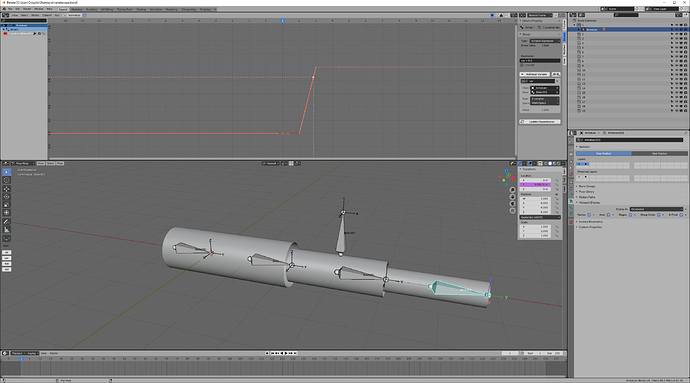How to show the position bone when setting up a constraint transformation.
For example a telescope rig at which the first sleeve rod fully extends and then the second sleeve rod and follow on.
Its now trial and error blender 2.80
hereby an example transformation constraints no bones
telescope.blend (639.0 KB)
Should I use damped track constraint or transformation constraint for making an extendable sleeve rod. Don’t want any dependency loops.
I can’t imagine how you’d use a damped track to do that… Transformation constraint or drivers seems like the way to go to me.
Looking at your file, it looks okay, although you have pointless constraints on cube.000 and cube.002 (if min=max, it always does it) , world space constraints places where you’d want local space constraints, and no parenting relationships (yet?).
Ok thanks I was testing find it difficult to set min and max because I could not see the location in the viewport. I want to make a transformation constraint bone rig. Mechanical rigs Is new to me mostly made character rigs.
Hey, The ‘Limit Distance’ constraint is a good choice for that, just ‘Target’ a bone you want to move by the ‘length’ (Distance in constraint) of the bone, keep chaining them together in this way then parent all of the bones to one main bone.
Tip; you may have to adjust the ‘distance’ more than once to get the desired results, also building it in the fully extended position (rig) helps.
Sorry what did you meant with pointless constraints min max?
I mean,t in the file you linked, you have several transformations constraints that have the same min and max values for the transform. That’s pointless, because it will always just move that value, regardless of whatever the target is doing.
Should I not set for every transformation constraint for the source min and max ?
You should. Both source and destination. Different mins from maxes.
O yes I see what you mean the first sleeve rod had to stay in place guess thats why I changed the source min max to zero. My mistake.
Still strugling to make the hydraulic telescopic bone rig. It should extend like in the example not like a normal telescopic.
Hey, here is a link to a file that contains 5 examples, none of them use the ‘Transformation’ constraint, if you still wish to use that constraint I will have to rig one up, but I stay away from it when ever possible - drivers are easier for me. Hope this helps.
https://drive.google.com/open?id=1VGPIXkB09pA5KxN_93lrWOarry0ccAxs
DISCLAIMER : File saved in 2.76,if your using 2.7x it will open fine…IF your using 2.8x then ‘APPEND’ the ‘Objects’ into your version.
EDIT: I updated file to include a couple examples that use the ‘Transformation’ constraint .
Thanks, here you see transformations constraint for more control telescope rig.
https://blender.stackexchange.com/questions/89251/how-can-i-rig-telescopic-parts-to-move-one-at-a-time
Updated the file with 2 examples.
Sorry not one example is what I am looking for.
The blue cylinder must first extend after that extend the the white cylinder and at last the red cylinder your examples extend like a normal telescope and have no negative limit.
I just never put any on them
So you want it to work in reverse order then, here is a link to a file that has just that. Hope this helps
https://drive.google.com/open?id=1EUoSSufsAj8FLCpMWWXkjbJYx6Z9qqsn
DISCLAIMER : File saved in 2.76,if your using 2.7x it will open fine…IF your using 2.8x then ‘APPEND’ the ‘Objects’ into your version.
The bone rig is for a hydraulic knuckleboom crane.
Sorry the telescopic_reverse is again not how it should work.
In your rig all parts extend but only the first rod should fully extend then the second fully etc.
Hey, now that I know what it is you are trying to replicate, the telescopic_reverse file is the correct action for such, but since this piece of machinery usually has that multiple sectioned booms, it is capable of the opposite action as well - since each section is ‘independent’ (controlled by its own hyd cyl) it could extend just the middle section.
So the main thing here would be to make smaller section a 'child of ’ the next larger section so when the ‘main’ section rotates/moves all is good. As far as how you want to rig it, I will leave you to make that decision that works best for you.
Yes thats why I used transformation constraint min and max.
To get more control. Thanks anyway.
I’d like the 1st piece (the biggest one, closest to the base), to fully extend first, then the next one and so on. Need an armature no object constraints. Did not know it is that hard.
Anyone?
